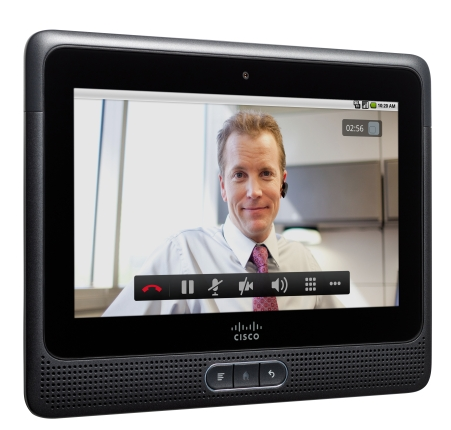Company after company is learning what most of instinctively know already – competing with Apple head-on is like trying to tackle a freight train with your bare hands as it is barreling down the tracks in your direction. Amazon with its Kindle Fire competed on price and used its services to subsidize the device. Other tablet makers are finding it virtually impossible to compete without such advantages.
So finding out the news that Cisco is discontinuing its Cius tablet isn’t a surprise. I have mentioned before that Cisco is not good at consumer products and although the Cius was targeted at the enterprise, we know IT has become “consumerized” meaning the CIO doesn’t drive tablet decisions. As a result, Cisco has to compete with Apple head-on which as described above is virtually impossible to do.
Cisco’s OJ Winge had this to say about the company’s tablet and software strategy going forward:
Over the last year, Cisco has demonstrated a commitment to delivering innovative software like Cisco Jabber and Cisco WebEx across a wide spectrum of operating systems, tablets and Smart Phones. We’re seeing tremendous interest in these software offerings. Customers see the value in how these offerings enable employees to work on their terms in the Post-PC era, while still having access to collaboration experiences.
Based on these market transitions, Cisco will no longer invest in the Cisco Cius tablet form factor, and no further enhancements will be made to the current Cius endpoint beyond what’s available today. However, as we evaluate the market further, we will continue to offer Cius in a limited fashion to customers with specific needs or use cases.
Moving forward, we intend to double down on software offerings, like Jabber and WebEx, that provide the anytime, anywhere, and any device experiences. We will leverage key learnings and key collaboration experiences native to Cius in our other collaboration products.
Experience matters, and Cisco is focused on empowering individual collaboration styles more effectively and securely, while providing the broadest choice of collaboration options based on preference, location, and device.
To give you a sense of just how fast the market moves it was 11 months ago where the press was invited to a Cius launch event. After the meeting I posted the video above and an entry titled Cisco Cius and the Need for an Enterprise Tablet. One of my concerns from the post was the following:
The challenges here are how many people want a seven-inch tablet when they can get a ten-inch tablet at a similar price? It is worth noting in my tests with the Cius and the Blackberry Playbook that you get used to the smaller form-factor and obviously there are some portability benefits to a smaller device.
Is Cius a winner? Yes – absolutely but that doesn’t mean it will be successful. Hear me out. The Cius and the Avaya A175 with the Flare interface are building a category called enterprise tablet and to date it isn’t clear if this is a real category or not. By real I mean – substantial in terms of the number of devices sold. In other words, other than some vertical markets like hospitals where IT generally directs such device rollouts, most other industries have seen the BYOD-effect of the consumerization of IT meaning IT doesn’t dictate as much as they used to. Moreover, many workers are purchasing their own tablets and bringing them to work – reducing corporate expense while keeping workers happier.
One final issue is the tablet market right now is pretty much all iPad and Android devices haven’t made much of a dent. Analysts believe this will change but some people of note believe it is possible for Apple to own the tablet space. Moreover, with the close synergy between iTunes and iCloud, Apple makes it that much more desirable to have your tablet come from the same company.
On the way to the event I wrote a post How Cisco Needs to Sell the Cius Tablet which also outlined the risks:
The downside risk is fairly obvious though and that is that software is cheaper than hardware and most anything the Cius can do, an iPad or other Android tablet can as well.
And then there is the consumer electronics angle – Cisco purchased Flip and shut it down a few years later because the company isn’t very good at competing in the consumer space where margins are razor-thin. Obviously the growth of smartphones helped kill the pocket-sized video camcorder market as well.
So for Cisco the obvious sales angle is to sell the Cius as an IP-phone which can do so much more. Avaya will obviously be doing the same with its A175 tablet. The challenge in the long-term will be convincing users that they want an Android tablet instead of an iPad. Which means both Avaya and Cisco need to be much better at doing consumer electronics – potentially partnering with a tablet maker like Samsung or HTC to one-up Apple.
I stand by my suggestion that the company should have partnered with a consumer electronics company. Now that Google Owns Motorola Mobility they could be a likely partner as well.
My sense is however that Cisco is so upset about its consumer electronics losses between Flip, Umi and Cius that they won’t be open to any such partnerships unless they have little or no risk associated with them.
I reached out to Avaya regarding their strategy and spoke with Joel Hackney, President of Sales and Field Operations. He told me they remain committed on extending video to all employees in the enterprise including mobile video and SIP leadership are very important areas for them. Their pending RADVISION acquisition gives them a full video offering allowing you to enhance your own device or purchase a complete solution.
The question now is will any other company be able to compete with Apple as a pure-play tablet maker. Google should be coming out with their solution soon and we will see what sort of acceptance there is in the market.






